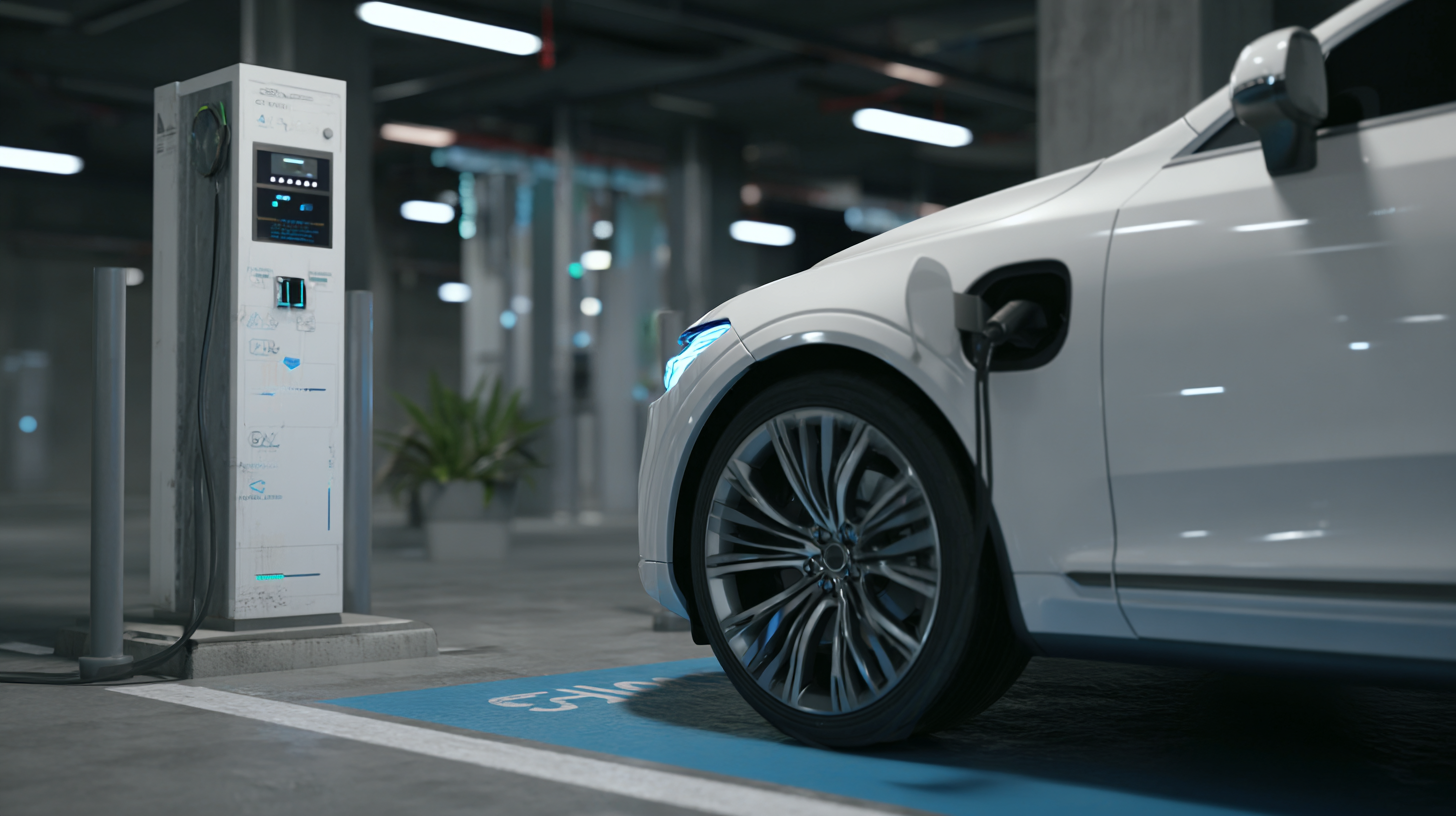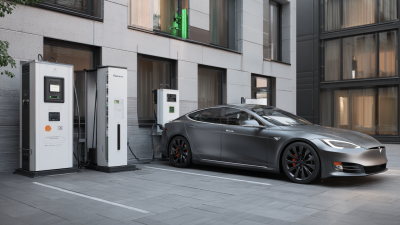
Wall Mounting EV Charge Station
Understanding the Benefits of Type 1 Ev Charger for Sustainable Electric Mobility
The transition to sustainable electric mobility is gaining momentum, as evidenced by a report from the International Energy Agency (IEA), which projects that global electric vehicle (EV) sales will reach 145 million by 2030. Within this evolution, the Type 1 EV Charger emerges as a crucial component, particularly in North America and regions with similar charging standards. This charger, utilizing a single-phase connection, provides a convenient and efficient way to power vehicles, ensuring that users can easily access charging stations. According to a study by the Electric Power Research Institute (EPRI), widespread adoption of Type 1 EV Chargers can lead to significant reductions in greenhouse gas emissions, as they support the increased integration of renewable energy sources into the grid. As we delve into the various benefits of Type 1 EV Chargers, it becomes clear that they play an essential role in fostering a sustainable future for electric mobility.

Benefits of Type 1 EV Chargers for Sustainable Transportation Solutions
Type 1 EV chargers play a crucial role in promoting sustainable transportation solutions, especially in urban environments. With an ongoing shift towards electric mobility, research shows that the electric vehicle (EV) market is set to grow significantly, with a projected market size of USD 40 billion for the charging infrastructure by 2034. This growth highlights the need for a robust and accessible charging network, particularly as 1.6 million EVs are already on the road, indicating diverse usage patterns among private users, taxis, and commercial fleets. Implementing Type 1 chargers can greatly facilitate this transition by providing a standardized, efficient charging option for a wide range of vehicles.
Furthermore, Type 1 EV chargers contribute to smart and sustainable street designs, aligning with the principles of smart growth. Studies indicate that the integration of innovative charging solutions with public infrastructure can enhance the overall effectiveness of EV adoption, ensuring that urban areas are equipped to manage the increasing demand. This not only benefits urban communities but also extends to rural areas, providing essential charging support that enables broader EV access. By fostering a robust charging network, Type 1 chargers help create a more sustainable transportation ecosystem, leading us towards a greener future.
Understanding the Benefits of Type 1 EV Charger for Sustainable Electric Mobility
| Benefit | Description | Impact on Sustainability |
|---|---|---|
| Cost-Effective Charging | Type 1 EV chargers are generally less expensive to install and maintain compared to other charger types. | Encourages more consumers to adopt electric vehicles, reducing fossil fuel usage. |
| Widespread Availability | Many public charging stations support Type 1 connectors, making charging more accessible. | Increases convenience for EV users, promoting sustainable transportation. |
| Faster Charging Times | Type 1 chargers often provide faster charging rates suitable for many electric vehicles. | Encourages usage of electric vehicles by reducing downtime. |
| Standardization | Type 1 has become a standard for many regions, making compatibility easier for EV owners. | Facilitates the growth of the EV market and infrastructure. |
| Environmental Impact | Encourages the use of renewable energy sources for charging. | Reduces greenhouse gas emissions from the transportation sector. |
Key Features of Type 1 EV Chargers Supporting Green Mobility
Type 1 EV chargers play a crucial role in promoting sustainable electric mobility by offering efficient charging solutions tailored for various electric vehicle models. One of the key features of these chargers is their user-friendly design, which allows for easy plug-and-play functionality. This simplicity encourages more users to adopt electric vehicles, knowing they can charge their vehicles without complicated procedures. Additionally, Type 1 chargers utilize a standard connector type compatible with numerous electric vehicles, enhancing accessibility and convenience for users, particularly in residential and commercial settings.
Another significant benefit of Type 1 EV chargers is their ability to support renewable energy integration. By allowing users to charge their electric vehicles during off-peak hours or when renewable energy sources, such as solar or wind, are abundant, these chargers contribute to a greener grid and reduce reliance on fossil fuels. Furthermore, many Type 1 chargers come equipped with smart technology that enables users to monitor their energy consumption and adjust charging times accordingly, fostering a more conscious approach to energy use. As a result, the implementation of Type 1 EV chargers not only supports individual electric mobility but also aligns with broader sustainability goals.
Comparative Analysis: Type 1 EV Chargers vs. Other Charging Options
Type 1 EV chargers are gaining traction in the market as they offer a unique combination of efficiency and accessibility compared to other charging options. In the U.S. electric vehicle charger manufacturing market, AC charging dominates with a significant 67.7% market share due to its affordability and the extensive infrastructure in place. This technical advantage positions Type 1 chargers favorably for consumers looking to transition to electric mobility without the obstacles of high installation costs or limited availability.
A comparative analysis of Type 1 chargers against other charging types—such as Level 2 and Level 3—reveals that while the latter are faster, they come with higher installation costs and require robust infrastructure investment. Level 2 chargers, often found in public spaces, serve users well, yet the simplicity and lower cost of Type 1 chargers, particularly for home use, make them an attractive option for consumers. The EV charging station market is projected to see a CAGR of 25.9%, indicating a growing acceptance and the critical role Type 1 chargers will play in achieving sustainable electric mobility. As access to public charging points becomes increasingly necessary, the importance of reliable and user-friendly charging solutions like Type 1 cannot be overstated.
Comparison of Charging Options for Electric Vehicles
How Type 1 EV Chargers Enhance Urban Infrastructure for Electric Vehicles
 The integration of Type 1 EV chargers into urban infrastructure is crucial for enhancing the sustainability of electric mobility. These chargers are designed to accommodate a variety of electric vehicles, providing a seamless charging experience for users. By strategically placing Type 1 chargers in urban areas such as shopping centers, parks, and residential neighborhoods, cities can greatly reduce range anxiety and promote the adoption of electric vehicles. This not only contributes to cleaner air and reduced greenhouse gas emissions but also encourages a more environmentally conscious community.
The integration of Type 1 EV chargers into urban infrastructure is crucial for enhancing the sustainability of electric mobility. These chargers are designed to accommodate a variety of electric vehicles, providing a seamless charging experience for users. By strategically placing Type 1 chargers in urban areas such as shopping centers, parks, and residential neighborhoods, cities can greatly reduce range anxiety and promote the adoption of electric vehicles. This not only contributes to cleaner air and reduced greenhouse gas emissions but also encourages a more environmentally conscious community.
Tips: To maximize the benefits of Type 1 EV chargers, cities should prioritize locations near essential amenities and ensure they are easily accessible to all users. Additionally, incorporating smart charging technology can optimize energy consumption and allow for real-time monitoring of charger availability.
As urban infrastructure evolves to support electric mobility, Type 1 chargers offer a foundational element for building a comprehensive charging network. Communities that invest in these chargers demonstrate a commitment to sustainability and innovation, attracting eco-conscious residents and visitors alike. As adoption rates of electric vehicles rise, the presence of reliable charging options will be pivotal in shaping the future of urban transportation.
Tips for Maximizing Efficiency with Type 1 EV Chargers in Daily Use
When it comes to optimizing the daily use of Type 1 EV chargers, maximizing efficiency is crucial for electric vehicle owners. According to a report from the International Energy Agency (IEA), more than 10 million electric cars were on the roads globally by 2020, and this number is expected to grow rapidly. Understanding the charging patterns of everyday users can lead to substantial savings and improved performance. For instance, charging during off-peak hours can reduce costs significantly, as many utility companies offer lower rates during these periods.
In addition, regular maintenance of Type 1 EV chargers can enhance their operational efficiency. A study by the U.S. Department of Energy highlighted that well-maintained charging infrastructure could improve charging speeds by up to 20%. This means users can spend less time plugged in, allowing for more convenient use of their vehicles. Utilizing smart charging technology can also aid in better energy management, ensuring that your vehicle is charged at the optimal time and conditions for both the car and the electric grid. Adopting these strategies can ensure that Type 1 EV chargers are not only effective in powering electric vehicles but also contribute to a more sustainable future in electric mobility.

Related Posts
-

5 Reasons Why Ac Ev Chargers Are the Future of Sustainable Transportation
-

Embracing Innovation: The Future of EV Charger Stations for Sustainable Transportation
-

7 Compelling Reasons to Choose an Ac Portable Ev Charger for Your Electric Vehicle
-

How to Choose the Best Ev Charger Station for Your Business Needs
-

Ultimate Guide to Choosing the Right Ev Charger Station for Your Needs
-

Unlock the Future: How EV Charger Stations are Revolutionizing Sustainable Transportation

